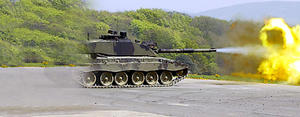In the trenchesInvisible tanks to be deployed within five years
British military scientists plan to develop an army of “invisible” tanks ready for use on the battlefield within five years. Armored vehicles will use a new technology known as “e-camouflage” which deploys a form electronic ink to render a vehicle invisible; highly sophisticated electronic sensors attached to the tank’s hull will project images of the surrounding environment back onto the outside of the vehicle enabling it to merge into the landscape and evade attack

This tank literally disappears into its environment // Source: dailymail.co.uk
British military scientists plan to develop an army of “invisible” tanks ready for use on the battlefield within five years. Armored vehicles will use a new technology known as “e-camouflage” which deploys a form electronic ink to render a vehicle invisible.
Highly sophisticated electronic sensors attached to the tank’s hull will project images of the surrounding environment back onto the outside of the vehicle enabling it to merge into the landscape and evade attack.
The electronic camouflage will enable the vehicle to blend into the surrounding countryside in much the same way that a squid uses ink to help as a disguise.
Unlike conventional forms of camouflage, the images on the hull would change in concert with the changing environment always insuring that the vehicle remains disguised.
In Helmand, for example, all armored vehicle have desert sand colored camouflage, which is of little use in the Green Zone, an area of cultivation where crops are grown and the Taliban often hide.
The Telegraph reports up until recently such concepts were thought to be the stuff of science fiction but scientists at the defense company BAE Systems now believe battlefield invisibility will soon become science fact.
Scientists at the BAE hope the new technology will be available to use with the British Army fighting in Southern Afghanistan and in future conflicts.
The concept was developed as part of the Future Protected Vehicle program, which scientists believe, will transform the way in which future conflicts will be fought.
The program is based around seven different military vehicles, both manned and unmanned, which will be equipped with a wide variety of lethal and none lethal weapons.
The unmanned vehicles or battlefield robots will be able to conduct dangerous missions in hostile areas, clear minefields and extract wounded troops under fire.
The vehicles include:
- Pointer: an agile robot which can take over dirty, dull or dangerous jobs, such as forward observation and mine clearance.
- Bearer: a modular platform which can carry a range of mission payloads, such as protected mobility, air defense and ambulance;
- Wraith: a low signature scout vehicle;
- Safeguard: an ultra-utility infantry carrier or command & control centre;
- Charger: a highly lethal and survivable reconfigurable attack vehicle;
- Raider: a remotely or autonomously controlled unmanned reconnaissance and skirmishing platform – similar in design to the “Batmobile”
- Atlas: a convoy system which removes the driver from harm’s way.
BAE’s Future vehicle project is, in part, a reaction to the Ministry of Defense’s (MoD) ‘Capability Vision’ for armored vehicles, designed to spur development along different paths from the MoD’s previous research.
Commanders are aiming for a prototype within four years and an experimental operational capacity by 2013.
The brief is for a lightweight vehicle, weighing thirty tons, powered by a hybrid electric drive, with the same effectiveness and survivability of a current main battle tank.
The UK’s current tank, the Challenger 2, weighs 62.5 tons, and runs a 1,200hp V12 diesel engine.
Britain’s current fleet of armored vehicles are also close to approaching the end of their service life and armored vehicles designed specifically for use in Helmand, such as the hugely successful Mastiff, may be inappropriate for use in other operational theatres.
Scientists at BAE are also looking at a number of revolution battlefield inventions which will increase troop protection as well as making the vehicles more lethal.
One concept being developed is to develop technologies, which will cut the use of fuel on the battlefield. In Afghanistan, the cost of fuel is fifty times that of the pump price.
All fuel currently used by NATO troops comes in via road convoys which are often attacked by insurgents which are responsible for 80 per cent of U.S. casualties.
Scientists are close to developing a form of transparent armor — much tougher than bullet proof glass – which could be used in turrets of on the sides of armored vehicles which would improve the situational awareness of troops inside.
Also being developed is a technology known as “biometric integration which uses advanced algorhythms to analyze crowds and to search for potential threats from suicide bombers by analyzing suspicious behavior in groups or individuals.
Electronic scanners would search for suspicious behavior, inappropriate clothing or individuals on wanted lists who can be identified through facial or iris recognition.
The information would then be displayed on screen within vehicle or handheld vehicles carried by dismounted troops.
Hisham Awad, the head of the Future Protected Vehicle project said: “The trick here is to use machines to do what they are best at (and humans are not) — ploughing very quickly through dull, repetitive data to strip out the overwhelming bulk which is of no use and would take a long time and enormous human resources to process. Then you can quickly bring human intelligence to bear where it excels - making life-or-death decisions based on ‘real time’ information on suspicious
activity flagged up by the machines.”
